 Paweł Lewandowski
Paweł Lewandowski Hedvig
Hedvig Steve Frous
Steve Frous Crystii Lin
Crystii Lin Guiri Uribe
Guiri Uribe
Under the glass roof of Paris's Palais Royal, fashion house Chanel roared to life on Tuesday with a glitzy show of haute couture that hinted at the spectacle and opulence of Romanov Russia.
Moving far away from signature Chanel black wool jackets, white trim and pearls, designer Karl Lagerfeld embraced sequins and baubles in a series of to-the-knee haute couture dresses that seemed defiantly spectacular amid the economic crisis.
Several suits sported gold brocade, intricate embroidery and fur lining. The colors -- earth tones and deep reds -- were warm and hinted at the darkened corridors of a Byzantine church or 18th century tapestry.
Models paraded under and around a 15 meter (45 foot) high lion -- an ode, the designer said, to the astrological sign of the house's eponymous founder, Coco Chanel.
Despite the opulence, the designer said that the show strove for simplicity, noting that none of the dresses were floor length, a traditional offering of haute couture.
"Everything has been removed...we had to strip a little but without making it dry, minimalist, false or pretentious," he said to reporters after the show.
Lagerfeld, who is roughly 75 years old and shows no sign of retiring, has turned Chanel into the power house of French haute couture.
Even as some haute couture designers like Christian Lacroix close their doors under the crushing expense of making dresses by hand for a clientele that may number no more than 300, Chanel has grown his couture collection.
"Lagerfeld made Chanel more Chanel than Chanel. What was it before Karl? Status...clothes for your mother. He infused it with fun, rock and modernity. He brought the house to life," said Aliona Doletskaya, editor of Russian Vogue.
And while other designers seem to be moving away from haute couture -- a rarefied world in which one dress can cost upwards of $40,000-- Chanel touts its legions of seamstresses who have the skills to create lace, brocade and embroidery by hand.
But several observers noted that Lagerfeld has begun moving further from the essence of Chanel. While he speaks of her influence often -- simplicity and comfort -- he has begun creating bright designs that play on metal themes.
For every comfortably tailored maroon suit shown Tuesday, there was a gilded dress that stopped at the unflattering knee-line.
"The coats were perfect," said 34-year old Yelena Grujic who was at the show and aspires to wear haute couture. "The dresses were lovely too. But the problem is where to wear them. If you walk into a room wearing that dress and you are the only one...everyone looks at you."
Buyers and admirers seemed to hone in on long flowing wool coats, shown at the beginning of the show, rather than the gilded dresses that were presented at the end.
"The coats were beautiful and the clothes were far more wearable than Dior," said Suad al Ghanim, a buyer of haute couture from Kuwait who said she also bought two Stephane Rolland dresses that day.
But the essence of haute couture was to create fantasy, she added, even if it defied wearability.
"The dresses? They were beautiful to see."
Casanova will set out to seduce theater-lovers this month on the old whipping grounds of his fellow roué, the Marquis de Sade.
And the man who's bringing the two together is a legend in his own right: Pierre Cardin, the modern master of de Sade's domain.
The 87-year-old fashion designer (who turns 88 on July 7) began restoring the castle of the Marquis a decade ago as part of his controversial plan to turn this hamlet some 60 miles (100km) north of Marseille into "the St. Tropez of culture."
The French premiere of "Casanova: Love and Betrayal in Venice" on Bastille Day (July 14) marks the 10th anniversary of the "Festival de Lacoste," Cardin's attempt to bring big-city culture to the Provencal countryside.
Performances take place in the open-air theater constructed by Cardin in the chateau's quarry-on the grounds where the Marquis staged his own theatrical productions, both respectable and obscene.
Depending on the year, Cardin's fest ranges from the Sade-centric to the eccentric, usually with a nod to the brand-savvy designer's pet projects.
This summer's line-up features "Le Petit Groom de Chez Maxim's," a farce set in the Parisian landmark that Cardin bought in the early 1980s and has since turned into a global chain of restaurants and hotels.
THE CASANOVA CONNECTION The Casanova connection is also close to Cardin's heart -- he's even designed the costumes for the show himself.
"I'm Italian, you know -- I'm Venetian," he told Reuters at the Lacoste Festival, a reminder that "Pierre" was originally known as "Pietro."
Cardin's parents fled the fascism of Mussolini to move to France, where their son began his career apprenticed to a tailor. Now a flesh-and-blood fashion label, Cardin is also the proud owner of the palazzo where Casanova trawled for love and money in Venice.
"It's very funny that I live in Casanova's villa and the Marquis de Sade's," he told me.
Still, not all of Lacoste's 420 inhabitants are happy with his designs on their community. Until now, the village has miraculously escaped gentrification.
Lacoste is ground zero of the "Year in Provence" dream, a castled hilltop of stone maisons and cobbled streets overlooking the cherry trees, olives and lavender of the Luberon Valley.
Former adman Peter Mayle began his 1989 bestseller with lunch at Lacoste and turned neighboring Ménerbes into a mecca for upscale tourists, while Hollywood actor John Malkovich has a house in the valley and the playwright Tom Stoppard has spent time living in the village itself.
BONJOUR, Y'ALL
In a surreal touch, much of Lacoste is already occupied by an art school from America's Deep South. The 'Lacoste campus' of the Georgia-based Savannah College of Art and Design is the legacy of Bernard Pfriem, an American painter who fell in love with Lacoste in the 1950s and began buying up buildings and restoring them.
But Cardin hopes to take Lacoste to a whole new level.
Besides the Marquis' chateau, the designer now owns some 40 buildings in the surrounding village, including the Café de Sade, a couple of galleries, a boulangerie, and a boutique that sells goodies from Maxim's; with plans for a restaurant, a couple of luxury hotels, and even a golf course.
The size of the castle's theater reflects the scale of his ambitions: it holds more than twice as many people as live in the village itself.
Cardin's opponents have organized petitions and letter-writing campaigns, likening the wealthy outsider to the feudal seigneurs like de Sade who lorded it over Lacoste for centuries.
In response, Cardin has said simply: "I just want to make the village beautiful."
Against that backdrop, the timing of opening may add a certain frisson to the Festival de Lacoste. Bastille Day commemorates a key event in the French Revolution, when ordinary citizens rose up to destroy a medieval prison-fortress that symbolized their oppression.
And sadism's namesake also played a role in the Storming of the Bastille. As one of its last inmates, the Marquis de Sade converted his urinal into a loudspeaker to provoke the protesters, claiming that his fellow prisoners were being slaughtered and needed to be rescued.
Ironically, his lies backfired.
De Sade was transferred to an insane asylum just days before the Bastille was liberated, and much of his writing was lost or destroyed in the looting.
Pierre Cardin's Festival de Lacoste runs from July 14 to August 6, with tickets ranging from around 30 euros to 140 euros ($40.25-$187.80), depending on the show.
Tests show the wide range of thermo-physiological properties in sports textiles
BÖNNIGHEIM (im) German manufacturers of sports textiles are among the most innovative companies in the textile industry. Researchers at the Hohenstein Institute in Bönnigheim are helping these companies to improve the functional properties of their textiles by developing practical construction guidelines.
In a recently completed research project: (AiF No. 15481 N), with funding from the Federal Ministry of Economics and Technology (BMWi) provided through the Federation of Industrial Research Associations (AIF), they drew specific conclusions about the physiological comfort characteristics of a variety of different types of knitted garments. The textile industry will be able to use the construction guidelines that resulted from the research work to continue
developing and optimising functional clothing for all kinds of different sports.
The research project entailed investigating a total of 34 assorted knitted fabrics in respect of their thermo-physiological characteristics. These samples varied in terms of their fibres (PES, PP, PA, WO and CO and some mixed fibres), weight per unit area (100 to 329g), surface finish (hydrophilic, bioactive) and knit structure(e.g. single-jersey or pique). Specially selected representative samples were tested in controlled trials involving volunteers wearing them in a climate-controlled room. The skin model was used to measure thermophysiological properties, i.e. how heat and moisture are transported through the textile.
When this data was combined with the results of skin sensory testing, it was possible to work out a comfort rating for each sample. The textiles were assessed along the lines of the German school marks system, from 1 = "very good" to 6 = "unsatisfactory".
On average, all the knitted sports textiles that were investigated received marks that were satisfactory or better for sports textile comfort (TK(S)). Nine samples were awarded marks of 1.0 to 1.5 (= "very good"). Chemical fibres were at a distinct advantage when it came to transporting liquid perspiration and the way they dried. On the other hand, the natural fibre samples made of wool and cotton had the edge when it came to retaining perspiration.Comparing pairs of samples of textiles where the main fibre was polyamide, but with and without a hydrophilic finish, showed that the hydrophilic finish had a negative effect on the level of comfort, because the fabric took longer to dry. However, applying a hydrophilic finish to samples made of propylene or a mixture of cotton and polypropylene gave a better result for comfort because they did not stick to the skin so much.
His signature style can be characterized as sexy to the point of excess, with an unabashed use of vibrant colour, streamlined cuts and a high fashion approach to both fabric choices and design. His work is inspired by and made for celebrities, socialites and the beautiful ones of the nightlife crowd, for whom getting attention is a serious daily commitment.
A Renaissance Man of the Post-Modern Age fashion is not an occupation it is a lifestyle of temporal pleasures and whole-hearted embrace of all things new, hot and hip. He does not take the back seat to the clothes, but revels in the cult of celebrity he has created for himself, both through his work and through his association with his celebrity clientele.
No, I'm not talking about the great Gianni Versace. The hot designs and bold attitude belong to Vancouver-based designer Bian Variani. Haute Couture Collection by Fashion Designer Bian Variani launched in Milan. The parallels between Versace and Variani are many. Both men developed an appreciation for fashion at a very early age and learned the intricacies of cut, construction and fit in their mothers' tailoring studios. Versace's enduring legacy is the spectacle quality of his runway shows, considered events in themselves not just for the clothes they displayed, but also for the audience they attracted. Variani has capitalized on this, understanding that a memorable runway show is perhaps the most effective marketing tool designers have at their disposal.
Variani is recognized by local fashion industry insiders as a marketing genius. Indeed, his runway shows are stunning visual displays, with everything from hip-hop dancers and live acts, to exotic cars and motorcycles on the catwalk, to Variani himself skydiving onto the stage. These shows provide the ultimate venue for self-exposure in the city where the hype of a good show often draws a bigger crowd than a display of the hottest fashion trends for the coming season. Variani's showmanship provides a good insight into his design philosophy, dare to be different. Variani's inspiration is culture itself, and his designs reference everything from urban music to celebrity lifestyles of glamour and excess. Ultimately, Variani's message is based on the celebration of individual expression.
Variani himself is something of a Renaissance Man. Well-read and well-travelled, he has studied everything from fashion to marketing to business law, and he is a renowned poet and writer. His approach to design, though, is decidedly post-modern. In an era when personal identity is characterized not by a singular unified look but by a collection of various facets, Variani's clothes serve to expose the more vibrant traits of today's fashion-conscious male consumer. Variani explains, "we are all entertainers looking through a wardrobe of personalities." This is why Variani's clothes are designed to help his clientele express exactly who they are as opposed to dictating who they should be.
As you might have guessed, getting your hands on an original Variani is not easy. The clothes are all custom-made and available only on a special order basis, with all of the patterns created and constructed in Milan. Why then did Variani choose Vancouver as the headquarters for his label? The answer lies in Variani's steadfast belief that Vancouver will soon be recognized not just as a leading fashion center, but as a trend-setting capital. Vancouver is already appreciated by the entertainment industry for its natural beauty, and its location makes it the ideal international hub for imports and exports. Variani believes that Vancouver is an evolving force for men, creating a movement of change.
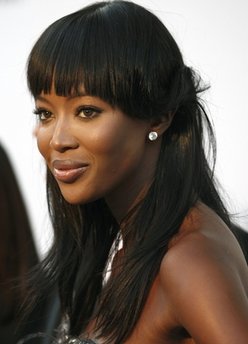 An international court Thursday subpoenaed reluctant supermodel Naomi Campbell to testify this month in the war crimes trial of former Liberian President Charles Taylor, warning her she could be jailed for up to seven years if she refuses.
An international court Thursday subpoenaed reluctant supermodel Naomi Campbell to testify this month in the war crimes trial of former Liberian President Charles Taylor, warning her she could be jailed for up to seven years if she refuses.
The Special Court for Sierra Leone issued the order forcing Campbell to testify after she avoided prosecutors for a year and made it known she had no wish to be part of the case.
She was ordered to appear in court in The Hague on July 29 at 9 am "or to show good cause why you cannot comply with this subpoena."
Refusal could lead to prosecution for contempt, which carries a maximum seven-year prison sentence and a fine of 2 million Sierra Leone leones, or about $510, according to the subpoena released by the court.
The appearance of Campbell, as well as of actress Mia Farrow and the model's former agent Carole White, who do not appear to have resisted testifying, will add a touch of glitz to a case already seen as a landmark, the first time a former African head of state has been put on trial by an international court.
The court said the summons will be delivered to Campbell's lawyer in London, Gideon Benaim, who has told the court he will accept it.
Nonetheless, the subpoena said, British authorities may be asked to "ensure that, you, Naomi Campbell, appear at the time and place indicated above."
Prosecutors had complained to the judges that they had tried unsuccessfully to contact Campbell several times since June 2009, when they received information that Taylor had given her a rough diamond as a gift during a celebrity-packed 1997 reception in South Africa hosted by then-President Nelson Mandela.
They said Campbell's testimony would support their contention that Taylor lied when he testified that he never possessed rough diamonds.
"The prosecution has shown that there is at least a good chance that the information to be provided by Ms. Campbell would be of material assistance to its case," said an earlier ruling dated Wednesday.
It cited Campbell's public statements that she "does not want to be involved in the case."
Taylor is accused of supporting rebels in Sierra Leone's 1991-2002 civil war, which claimed an estimated 500,000 victims of killings, systematic mutilation or other atrocities, with some of the worst crimes committed by child soldiers who were drugged to desensitize them.
In return for helping the rebels, prosecutors say Taylor plundered the neighboring country of its timber and mineral wealth, including gems that became known as "blood" diamonds.
His trial is being held in The Hague for fear of renewed violence if hearings were conducted in Sierra Leone. After several false starts, it began in earnest in January 2008. Taylor's own testimony took seven months.
Defense attorneys objected to the request to summon Campbell, arguing that the prosecution had concluded its case 18 months ago and that Campbell's story is irrelevant since she cannot testify to any connection between the diamond and Taylor's alleged involvement with Sierra Leone rebels. The court ruled earlier this week, however, that the prosecution could summon the three women.
Farrow already has given a written statement to the court that Campbell told her about the gift, but the judges refused to accept the statement when the prosecution tried to introduce it as evidence last January. Under cross-examination, Taylor said the story was "totally incorrect."
A model displays dress and jewllery in Hong Kong, south China, June 30, 2010. The online store www.hongkongdg.com cooperated by Taobao and Design Gallery under Hong Hong Trade Development Council officially opened Wednesday. The goods on sale are all designed in Hong Kong.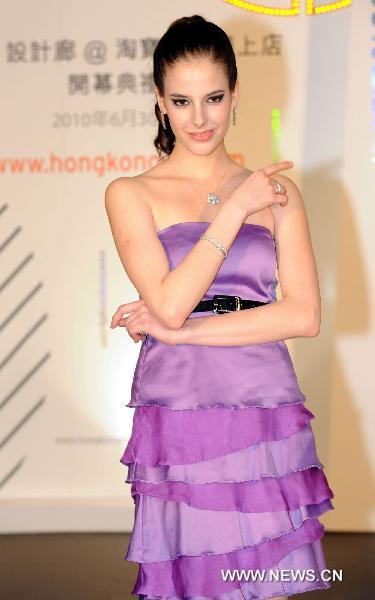
A model displays a bag in Hong Kong, south China, June 30, 2010. The online store www.hongkongdg.com cooperated by Taobao and Design Gallery under Hong Hong Trade Development Council officially opened Wednesday. The goods on sale are all designed in Hong Kong.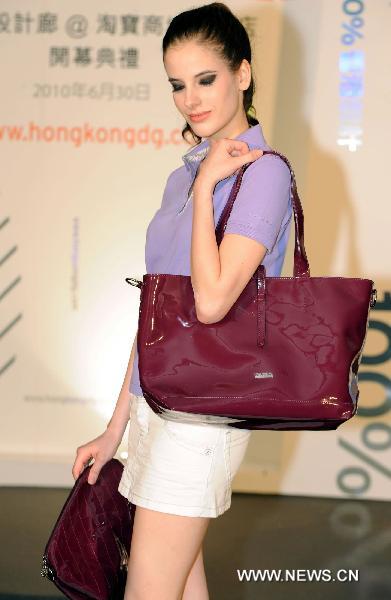
A model displays watch and clothes in Hong Kong, south China, June 30, 2010. The online store www.hongkongdg.com cooperated by Taobao and Design Gallery under Hong Hong Trade Development Council officially opened Wednesday. The goods on sale are all designed in Hong Kong.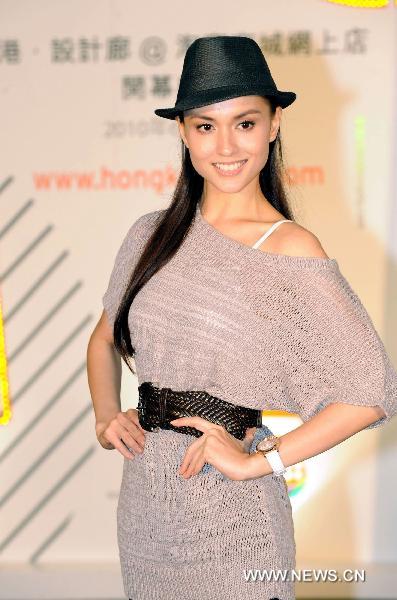
World Brand Laboratory released the 7th China's 500 Most Valuable Brands on 28th, June. These brands are selected based on the analyses of their finance, consumer behavior and brand influence. Among all these brands, 53 are brands of textile and garment, accounting 10.62%.
The 37-ranked Erdos is the first among these entire 53 textile and garment brands with the brand value of 30.326 billion Yuan. Kingboxing comes after ranking 50 with the brand value of 14.877 billion. The third is Youngor ranking 85 with the brand value of 9.334 billion Yuan.
Since the first China's 500 most valuable brands released in 2004, Chinese enterprises are increasingly aware of the importance of brands. Now, they pay much more attention to the brand image and brand management. The brand value increased from 61.232 billion Yuan in 2004 to 129.071 billion Yuan in 2010.
This year's most valuable brands are from 26 diverse industries. Most brands are of food and beverage, accounting 15.20%.
29th, June is the national day of Denmark at World Expo. On that day, Chinese fashion was used to illustrate Andersen Fairy Tales. Could you image how that would be? Copenhagen leather creations featured with both Chinese and Western elements presented guests and the Crown Prince of Demark, Frederik a fascinating fashion show.
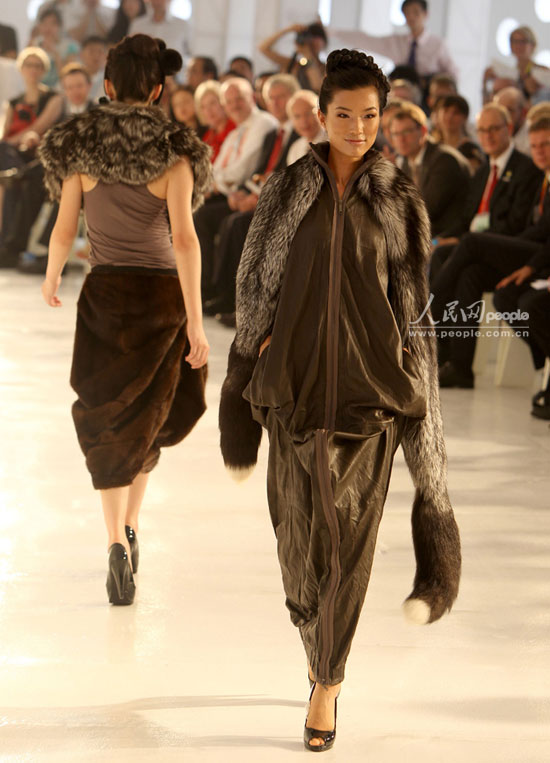
This fashion show told three most famous fairy tales of Andersen. The first one was “Nightingale". Creations of young designers from Academy of Arts& Design, Tsinghua University stunned the guests.
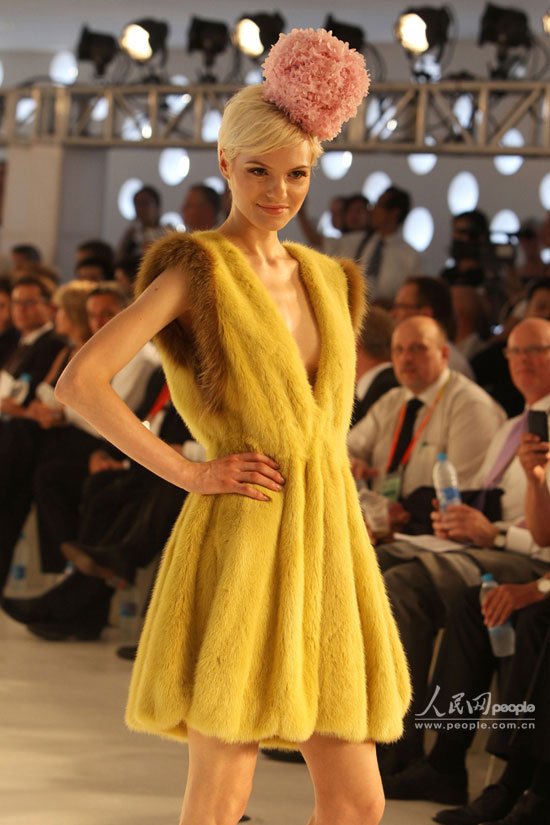
 More than 1,500 exhibitors will take part in the 17th Hong Kong Fashion Week for Spring/Summer 2011 and the 7th Summer Sourcing Show for Gifts, Houseware & Toys running 5-8 July at the Hong Kong Convention and Exhibition Centre (HKCEC). The concurrent events are organised by the Hong Kong Trade Development Council (HKTDC).
More than 1,500 exhibitors will take part in the 17th Hong Kong Fashion Week for Spring/Summer 2011 and the 7th Summer Sourcing Show for Gifts, Houseware & Toys running 5-8 July at the Hong Kong Convention and Exhibition Centre (HKCEC). The concurrent events are organised by the Hong Kong Trade Development Council (HKTDC).
Highlights of Fashion Week include themed zones, such as the Brand Name Gallery and the International Fashion Designers’ Showcase. There will also a number of catwalk events to showcase the creative work of fashion designers from around the world. Internationally acclaimed trend forecasters and industry players also are invited to speak at four seminars.
Concurrent with the Fashion Week, the Summer Sourcing Show for Gifts, Houseware & Toys will provide opportunities to source quality products with creative design for the year-end peak shopping period.
Fair Details:
Date: 4-8 July
Venues: Hong Kong Fashion Week for Spring/Summer Hall 1, 3B-E, HKCEC
Summer Sourcing Show for Gifts, Houseware & Toys Hall 3F-G, HKCEC
Opening Hours:
5 July (Mon) 10am-6pm
6-7 July (Tue-Wed) 9:30am-6pm
8 July (Thu) 9:30am
Leading domestic fashion producer Shenzhen Copais Industrial has launched a lawsuit against SKN, an arm of South Korea-based SK Group.
Copais is suing SKN claiming they failed to fulfill its commitment based on contracts with OBZEE, a company SKN acquired in 2007.
The total loss for Copais is expected to hit 500-600 million yuan ($73.7 million to 88.4 million).
In 2005, Copais inked contracts with OBZEE to become the sole agent and operator of top South Korean fashion brand Kang Jin Young in China. Based on the contract, Copais was due to open 50 shops of the brand in top end shopping malls in China within five years.
According to Zhao Yunhu, president of Copais, SKN made a series of "malicious" deeds to hinder Copais' efforts to open enough shops of the luxurious brand and decided to use the excuse to terminate their contracts.
SKN stressed that, to date, Copais only opened 17 shops.
However, Copais said it applied to launch 60 stores, and SKN.
Since the merger in late 2007, only fewer than five shops have been authorized by SKN to be opened.
Zhao said he contacted SKN for more than two years, but SKN, which eyed Kang Jin Young's sound sales growth in China, revealed ambitions to operate the brand by itself.